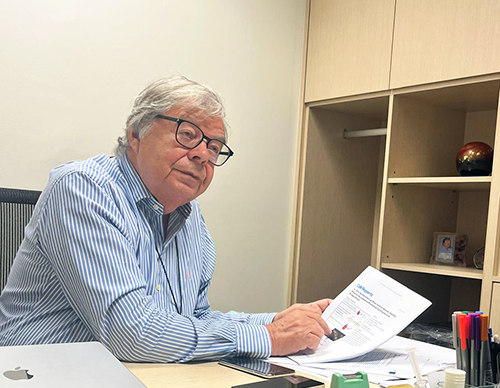Back
Tuesday, 05 Nov, 2024
Passion for research, compassion for patients.
Since arriving at Duke-NUS Medical School back in 2012, Prof Karl Tryggvason, known for his extensive work on basement membranes and laminins, has expanded the possibilities for regenerative medicine. He and his team at the Signature Research Programme in Cardiovascular and Metabolic Disorders (CVMD) successfully used laminin to culture human skin cells to treat burn wounds, photoreceptors to prevent and treat blindness, as well as to regenerate heart muscles.
Earlier this year in 2024, Duke-NUS awarded Prof Tryggvason the honorary title of Emeritus Professor in recognition of his many scientific accomplishments which have impacted the lives of patients, as well as his invaluable contributions in mentoring the next generation of researchers.
“Karl is known for his focus and passion for excellence and innovation. He is an exemplary faculty of CVMD, who has made a huge impact on how we think, how we teach, and how we bring scientific discovery to advance tomorrow’s medicine,” said Prof Wang Yibin, Programme Director of CVMD.
Sharing his views was Prof Patrick Tan, Senior Vice Dean of Research at Duke-NUS, “Karl brought unmatched focus, passion, and high standards for research and impact. Beyond his own lab, Karl influenced all of us and particularly the next generation of researchers on how we should approach science and bring our research to society.”
On 30 January, the Duke-NUS community came together to celebrate his work at a mini symposium which was graced by a star-studded line-up of local and international speakers, including mentees whose lives he influenced during his scientific career.

From left: Prof Wang Yibin, Prof Thomas Coffman (Dean, Duke-NUS), Prof Tryggvason and his wife at the celebratory symposium.
Giving back to diabetes research
Funding is the lifeblood of research and innovation. No one understands that better than the former Tanoto Foundation Professor in Diabetes Research. In support of the School’s continuing diabetes research into using human stem cells to restore insulin production, Prof Tryggvason gifted Duke-NUS $200,000 to establish the Pancreatic Cell Therapy Fund.
During his time at Duke-NUS, Prof Tryggvason led his team to discover a new method of pancreatic cell culture that could restore the body’s ability to produce insulin. With this gift, the team could continue with their research and eventually take it from bench to bedside.
Diabetes is a major health problem globally. Here in Singapore, more than 400,000 people live with diabetes, with the number projected to rise to 1 million by 2050. Diabetes occurs when the body is unable to produce enough insulin to control blood sugar levels or the body is unable to use the insulin effectively. Insulin is produced in the pancreas by islet cells. Transplanting healthy islets into the pancreas to restore insulin production offers hope of a long-term treatment. However, there is a lack of cadaveric pancreas donors and lab-grown islets usually die within 16 hours before they could be transplanted.
Prof Tryggvason’s method of culturing pancreatic islet cells using laminin technology is free from the above limitations. This is a major step forward in finding a cure for diabetes, and new hope for patients worldwide.

Prof Tryggvason explaining his method of culturing pancreatic islet cells using laminin technology.
No vacation for diabetic patients
“Diabetes is a terrible disease, especially for patients with Type 1 diabetes” said Prof Tryggvason.
“They need to measure their blood sugar and inject insulin every single day. No day offs. I remember this lady telling me how her husband was like a prisoner of the disease. He doesn’t get a break from all the insulin jabs. The word ‘prisoner’ left a deep impression on me.”
“The team is close to finding a potential cure – insulin-producing human cells. This is why I hope my gift can help them accelerate towards the finish line and bring it to the patients. So that they no longer need to rely on daily insulin jabs, and enjoy better quality of life.”
One beneficiary of the Pancreatic Cell Therapy Fund is Dr Krismundur Sigmundsson, a Principal Research Fellow who worked closely with Prof Tryggvason.
“I first met Karl at the Karolinska Institutet back in 2003. Nine years later, he invited me to join his new team at Duke-NUS and I came over in 2013. My initial contract was for three years but the projects just kept getting increasingly exciting! So I’ve been here ever since,” explained Dr Sigmundsson.
“Karl is a visionary and scientific architect. He confidently devises ambitious projects, delegating complex details to specialists for optimal and often challenging solutions.”
According to Dr Sigmundsson, working with Prof Tryggvason does indeed come with some very unique challenges.
“Having lived and worked in many countries, Karl is highly skilled in languages. He often doesn't realize which language he's using. It's common for him to rush out of his office to inform me of something important in Finnish, then immediately switch to Icelandic when speaking to a Finnish colleague. In the lab, he might address the staff in Swedish unless they prompt him to switch to English. Although he knows I don't speak Finnish, I occasionally receive short emails from him in Finnish. This is where Google Translate comes in handy. And I respond with a short reply, in Finnish!”
And here’s from us to you, Prof Tryggvason: “Þakka þér fyrir!” (“Thank you” in Icelandic, his native language).
Thank you for your immense contributions and generosity!